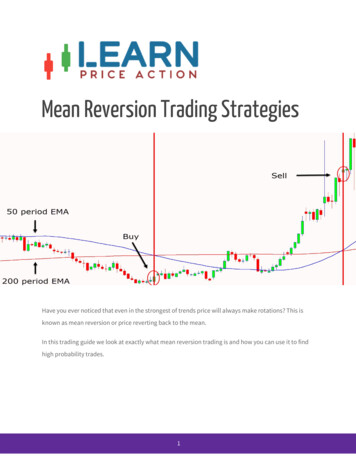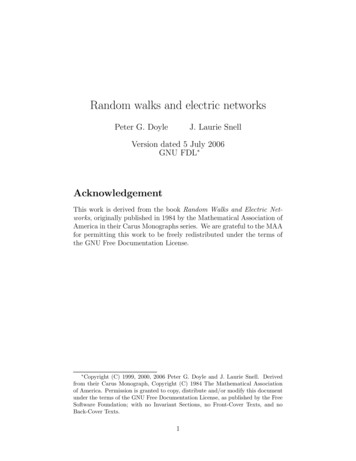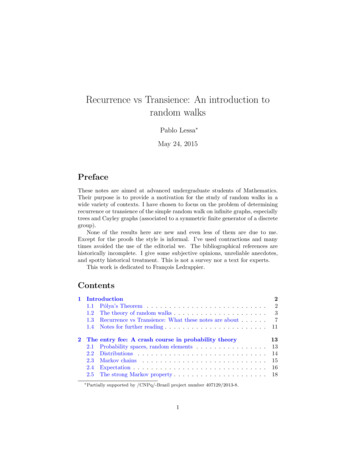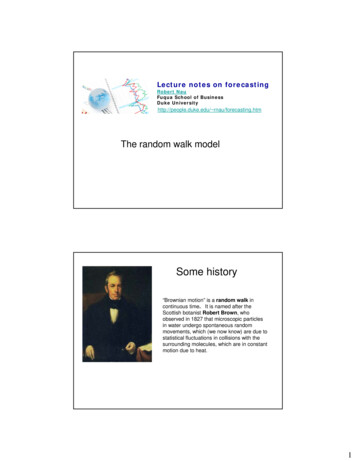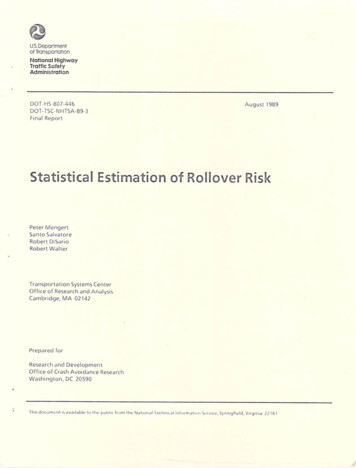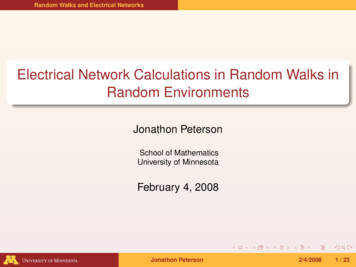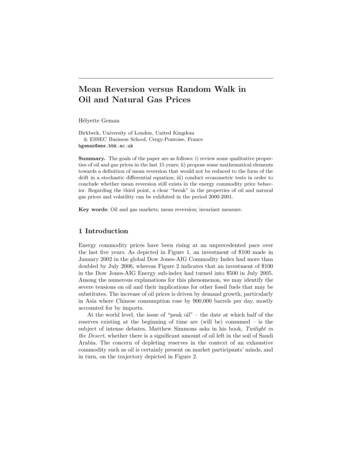
Transcription
Mean Reversion versus Random Walk inOil and Natural Gas PricesHélyette GemanBirkbeck, University of London, United Kingdom& ESSEC Business School, Cergy-Pontoise, Francehgeman@ems.bbk.ac.ukSummary. The goals of the paper are as follows: i) review some qualitative properties of oil and gas prices in the last 15 years; ii) propose some mathematical elementstowards a definition of mean reversion that would not be reduced to the form of thedrift in a stochastic differential equation; iii) conduct econometric tests in order toconclude whether mean reversion still exists in the energy commodity price behavior. Regarding the third point, a clear “break” in the properties of oil and naturalgas prices and volatility can be exhibited in the period 2000-2001.Key words: Oil and gas markets; mean reversion; invariant measure.1 IntroductionEnergy commodity prices have been rising at an unprecedented pace overthe last five years. As depicted in Figure 1, an investment of 100 made inJanuary 2002 in the global Dow Jones-AIG Commodity Index had more thandoubled by July 2006, whereas Figure 2 indicates that an investment of 100in the Dow Jones-AIG Energy sub-index had turned into 500 in July 2005.Among the numerous explanations for this phenomenon, we may identify thesevere tensions on oil and their implications for other fossil fuels that may besubstitutes. The increase of oil prices is driven by demand growth, particularlyin Asia where Chinese consumption rose by 900,000 barrels per day, mostlyaccounted for by imports.At the world level, the issue of “peak oil” – the date at which half of thereserves existing at the beginning of time are (will be) consumed – is thesubject of intense debates. Matthew Simmons asks in his book, Twilight inthe Desert, whether there is a significant amount of oil left in the soil of SaudiArabia. The concern of depleting reserves in the context of an exhaustivecommodity such as oil is certainly present on market participants’ minds, andin turn, on the trajectory depicted in Figure 2.
228Hélyette GemanFig. 1. Dow Jones-AIG Total Return Index over the period Jan 2002–July 2006.Fig. 2. Dow Jones-AIG Energy Sub-Index over the period Jan 2000–July 2005.
Mean Reversion versus Random Walk in Oil and Natural Gas Prices229Fig. 3. Goldman Sachs Commodity Index Total Return and Dow Jones-AIG Commodity Index total return over the period Feb 1991–Dec 1999.The financial literature on commodity price modeling started with the pioneering paper by Gibson and Schwartz [7]. In the spirit of the Black-ScholesMerton [2] formula, they use a geometric Brownian motion for oil spot prices.Given the behavior of commodity prices during the 1990s depicted in Figure 3 by the two major commodity indexes, [10] introduces a mean-revertingdrift in the stochastic differential equation driving oil price dynamics; [14], [4],[12] keep this mean-reversion representation for oil, electricity and bituminouscoal.The goal of this paper is to revisit the modelling of oil and natural gasprices in the light of the trajectories observed in the recent past (see Figure2), as well as the definition of mean reversion from a general mathematicalperspective. Note that this issue matters also for key quantities in finance suchas stochastic volatility. Fouque, Papanicolaou and Sircar [5] are interested inthe property of clustering exhibited by the volatility of asset prices. Theirview is that volatility is ‘bursty’ in nature, and burstiness is closely relatedto mean reversion, since a bursty process is returning to its mean (at a speedthat depends on the length of the burst period).
230Hélyette Geman2 Some Elements on Mean Reversion in Diffusion from aMathematical PerspectiveThe long-term behavior of continuous time Markov processes has been thesubject of much attention, starting with the work of Has’minskii [8]. Accordingly, the long-term evolution of the price of an exhaustible commodity, suchas oil or copper, is a topic of major concern in finance, given the world geopolitical and economic consequences of this issue. In what follows, (Xt ) willessentially have the economic interpretation of a log-price. We start with aprocess (Xt ) defined as solution of a stochastic differential equationdXt b (Xt ) dt σ (Xt ) dWt ,where (Wt ) is a standard Brownian motion on a probability space (Ω, F, P)describing the randomness of the economy. We know from Itô that if b andσ are Lipschitz, there exists a unique solution to the equation. If only b isLipschitz and σ Holder of coefficient 12 , we still have existence and uniquenessof the solution. In both cases, the process (Xt ) will be Markov and the driftb (Xt ) will contain the representation of the trend perceived at date t for futurespot prices.Given a process (Xt ), we are in finance particularly interested in the possible existence of a distribution for X0 such that, for any positive t, Xt hasthe same distribution. This distribution, if it exists, may be viewed as anequilibrium state for the process. We now recall the definition of an invariant probability measure for a Markov process (Xt )t 0 , whose semi-group isdenoted (Pt )t 0 and satisfies the property that, for any bounded measurablefunction, Pt f (x) E [f (Xt )].Definition 1. (i) A measure µ is said to be invariant for the process (Xt ) ifand only ifZZµ (dx) Pt f (x) µ (dx) f (x) ,for any bounded function f . (ii) µ is invariant for (Xt ) if and only if µPt µ.Equivalently, the law of (Xt u )u 0 is independent of t if we start at date 0with the measure µ.Proposition 1. The existence of an invariant measure implies that the process (Xt ) is stationary. If (Xt ) admits a limit law independent of its initialstate, then this limit law is an invariant measure.Proof. The first part of the proposition is nothing but Rone of the two formsof the definition above. Now suppose E [f (Xt )] t µ (dy) f (y), for anybounded function f . ThenZEX [f (Xt s )] EX [PS f (Xt )] t µ (dy) f (y) .Hence, µPS µ, and µ is invariant.ut
Mean Reversion versus Random Walk in Oil and Natural Gas Prices231Proposition 2. 1. The Ornstein-Uhlenbeck process admits a finite invariantmeasure, and this measure is Gaussian.2. The Cox-Ingersoll-Ross (or square-root) process also has a finite invariantmeasure.3. The arithmetic Brownian motion (like all Lévy processes) admits theLebesgue measure as an invariant measure, hence, not finite.4. A (squared) Bessel process exhibits the same property, namely an infiniteinvariant measure.Proof. 1. For φ : R R in C 2 , consider the Smoluchowski equationdXt φ0 (Xt ) dt dWt ,where Wt is a standard Brownian motion. Then the measure µ (dx) e2φ(x) dx is invariant for the process (Xt ). If we consider now an OrnsteinUhlenbeck process (with a standard deviation equal to 1 for implicity),then dXt (a bXt ) dt dWt , a, b 0, φ0 (x) a bx, φ (x) c ax bx2 bx2 2ax cdx is an invariant measure (normalized to2 , and µ (dx) e1 through c), and we recognize the Gaussian density. In the general caseof an Ornstein Uhlenbeck process reverting to the mean m, and¡ with astandard deviation equal to σ, the invariant measure will be N m, σ 2 .2. We recall the definition of the squared-root (or CIR) process introducedin finance by Cox, Ingersoll, and Ross [3]:pdXt (δ bXt ) dt σ Xt dWt .We remember that a CIR process is the square of the norm of a δdimensional Ornstein-Uhlenbeck process, where δ is the drift of the CIRprocess at 0. The semi-group of a CIR process is the radial projection ofthe semi-group of an Ornstein Uhlenbeck. If we note v, the image of µ bythe radial projectionZZZZv (dr) φ (r) µ (dx) Pt (φ · ) (x) µ (dx) Pt φ ( x ) v (dr) Pt φ (r) .Hence v, image of µ by the norm application, is invariant for Pt .3. Consider a Levy process (Lt ) and Pt its semi-group. ThenPt (x, f ) E0 [f (x Lt )] ,·Z ZZdxPt (x, f ) F ubini E0f (x Lt ) dx f (y) dy.Consequently, the Lebesque measure is invariant for the process (Lt ).4. We use the well-known relationship between a Bessel process and thenorm of Brownian motion and also obtain an infinite invariant measurefor Bessel processes.ut
232Hélyette GemanHaving covered the fundamental types of Markovian diffusions used infinance, we are led to propose the following definition.Definition 2. Given a Markov diffusion (Xt ), we say that the process (Xt )exhibits mean reversion if and only if it admits a finite invariant measure.Remarks.1. The definition does not necessarily involve the drift of a stochastic differential equation satisfied by (Xt ), as also suggested in [11].2. It allows inclusion of high-dimensional non-Markovian processes drivingenergy commodity prices or volatility levels.3. Following [13], we can define the setTP {probability measure µ such that µPt µ t 0}.Then the set TP is convex and closed for the tight convergence topology(through Feller’s property) and possibly empty. If TP is not the empty setand compact (for the tight convergence topology), there is at least oneextremal probability µ in TP . Then the process (Xt ) is ergodic for thisXmeasure µ : for any set A F that is invariant by the time translatorsX(θt )t 0 , then Pµ (A) 0 or 1, where we classically denote F the naturalfiltration of the process (Xt ). The time-translation operator θt is definedon the space Ω by (θt (X))s Xt s . It follows by Birkhoff’s theorem that,for any function F L1 (Pµ ),Z1 tF (Xs ) ds EPµ [F (X)] Pµ a.s.t 0when t . The interpretation of this result is the following: the longrun time average of a bounded function of the ergodic process (Xt ) isclose to its statistical average with respect to its invariant distribution.This property is crucial in finance, as the former quantity is the only onewe can hope to compute using an historical database of the process (Xt ).3 An Econometric Approach to Mean Reversion inEnergy Commodity PricesWe recall the classical steps in testing mean reversion in a series of prices(Xt ). The objective is to check whether in the representationXt 1 ρXt εt ,the coefficient ρ is significantly different from 1. The H0 hypothesis is theexistence of a unit root (i.e., ρ 1). A p-value smaller than 0.05 allows one toreject the H0 hypothesis with a confidence level higher than 0.95, in which casethe process is of the mean-reverting type. Otherwise, a unit root is uncovered,and the process is of the “random walk” type. The higher the p-value, themore the random walk model is validated.
Mean Reversion versus Random Walk in Oil and Natural Gas Prices2333.1 Mean-Reversion TestsThey are fundamentally of two types:(i) The Augmented Dickey-Fuller (ADF) consists in estimating the regressioncoefficient of p (t) on p (t 1). If this coefficient is significantly below 1, itmeans that the process is mean reverting; if it is close to 1, the process isa random walk.(ii) The Phillips-Perron test consists in searching for a unit root in the equationlinking Xt and Xt 1 . Again, a high p-value reinforces the hypothesis of aunit root.3.2 Statistical Properties Observed on Oil and Natural Gas PricesFor crude oil, a mean-reversion pattern prevails over the period 1994-2000;it changes into a random walk (arithmetic Brownian motion) as of 2000;whereas for natural gas, there is a mean-reversion pattern until 1999;since 2000, a change into a random walk occurs, but with a lag comparedto oil prices;during both periods, seasonality of gas prices tends to blur the signals.For US natural gas prices over the period January 1994–October 2004,spot prices are proxied by the New York Mercantile Exchange (NYMEX)one-month futures contract. Over the entire period Jan 1994–Oct 2004, theADF p-value is 0.712 and the Phillips Perron p-value is 0.1402, whereas overthe period Jan 1999–Oct 2004, the ADF p-value is 0.3567 and the PhillipsPerron p-value is 0.3899. Taking instead log-prices, the numbers becomeJan 94 - Oct 04Jan 99 - Oct 04ADF p-value 0.0863ADF p-value 0.4452Phillips Perron p-value 0.0888 Phillips Perron p-value 0.4498Over the last five years of the period, the arithmetic Brownian motion assumption clearly prevails and mean reversion seems to have receded.For West Texas Intermediate (WTI) oil spot prices over the same periodJanuary 1994–October 2004, again spot prices are proxied by NYMEX onemonth futures prices, and the tests are conducted for log-prices.1994-2004Jan 1999 - Oct 2004ADF p-value 0.651ADF p-value 0.7196Phillips Perron 0.5048 Phillips Perron 0.5641The mean-reversion assumption is strongly rejected over the whole periodand even more so over the recent one. Because of absence of seasonality, thebehavior of a random walk is more pronounced in the case of oil log-pricesthan in the case of natural gas.
234Hélyette Geman4 The Economic Literature on Mean Reversion inCommodity PricesIn [1], the term structure of futures prices is tested over the period January1982 to December 1991, for which mean reversion is found in the 11 marketsexamined, and it is also concluded that the magnitude of mean reversion islarge for agricultural commodities and crude oil, and substantially less formetals. Rather than examining evidence of ex-post reversion using time seriesof asset prices, [1] uses price data from futures contracts with various horizonsto test whether investors expect prices to revert. The “price discovery” elementin forward and futures prices is related to the famous “Rational ExpectationsHypothesis” long tested by economics, for interest rates in particular (cf. [9]),and stating that forward rates are unbiased predictors of future spot rates. [1]analyzes the relation between price levels and the slope of the futures termstructure defined by the difference between a long maturity future contractand the first nearby. Assuming that futures prices are unbiased expectations(under the real probability measure) of future spot prices, an inverse relationbetween prices and this slope constitutes evidence that investors expect meanreversion in spot prices, as it implies a lower expected future spot when pricesrise. The authors conclude the existence of mean reversion for oil prices overthe period 1982-1999; however, the same computations conducted over theperiod 2000-2005 leads to inconclusive results.Pindyck [12] analyzes 127 years (1870-1996) of data on crude oil and bituminous coal, obtained from the US Department of Commerce. Using a unitroot test, he shows that prices mean revert to stochastically fluctuating trendlines that represent long-run total marginal costs but are themselves unobservable. He also finds that during the time period of analysis, the randomwalk distribution for log-prices, i.e., the geometric Brownian motion for spotprices, is a much better approximation for coal and gas than oil. As suggestedby Figure 4, the recent period (2000-2006) has been quite different.One way to reconcile the findings in [12] and the properties we observedin the recent period described in this paper, is to “mix” mean reversion forthe spot price towards a long-term value of oil prices driven by a geometricBrownian motion. The following three-state variable model also incorporatesstochastic volatility:dSt a (Lt St ) St dt σt St dWt1 , dyt α (b yt ) dt η yt d Wt2 ,where yt σt2 ,dLt µLt dt ξLt dWt3 ,where the Brownian motions are positively correlated. The positive correlationbetween W 1 and W 2 accounts for the “inverse leverage” effect that prevails forcommodity prices (in contrast to the “leverage effect” observed in the equitymarkets), whereas the positive correlation between W 1 and W 3 translatesthe fact that news of depleted reserves will generate a rise in both spot andlong-term oil prices.
Mean Reversion versus Random Walk in Oil and Natural Gas Prices235Fig. 4. NYMEX Crude Oil Front: month daily prices over the period Jan 2003–Aug2005.5 ConclusionFrom the methodological standpoint, more work remains to be done in orderto analyze in a unified setting (i) the mathematical properties of existence ofan invariant measure and ergodicity for a stochastic process, and (ii) the meanreversion behavior as it is intuitively perceived in the field of finance. Froman economic standpoint, the modeling of oil and natural gas prices shouldincorporate the recent perception by market participants of the importanceof reserves uncertainty and exhaustion of these reserves.References1. H. Bessembinder, J. Coughenour, P. Seguin and M. Smoller. Mean reversion inequilibrium asset prices: Evidence from the futures term structure. Journal ofFinance, 50:361–375, 1995.2. F. Black and M. Scholes. The pricing of options and corporate liabilities. Journalof Political Economy, 81:637–659, 1973.3. J.C. Cox, J.E. Ingersoll and S.A. Ross. A theory of the term structure of interestrates. Econometrica, 53:385–408, 1985.4. A. Eydeland, and H. Geman. Pricing power derivatives. RISK, 71–73, September1998.5. J.P. Fouque, G. Papanicoleou and K.R. Sircar. Derivatives in Financial Marketswith Stochastic Volatility. Cambridge University Press, 2000.
236Hélyette Geman6. H. Geman. Commodities and Commodity Derivatives: Modeling and Pricing forAgriculturals, Metals and Energy. Wiley, 2005.7. R. Gibson and E.S. Schwartz. Stochastic convenience yield and the pricing ofoil contingent claims. Journal of Finance, 45:959–976, 1990.8. R.Z. Has’minskii. Stochastic Stability of Differential Equations. Sitjthoff & Noordhoff, 1980.9. Keynes, J.M. The Applied Theory of Money. Macmillan & Co., 1930.10. R.H. Litzenberger and N. Rabinowitz. Backwardation in oil futures markets:Theory and empirical evidence. Journal of Finance, 50(5):1517–1545, 1995.11. M. Musiela. Some issues on asset price modeling. Isaac Newton Institute Workshop on Mathematical Finance, 2005.12. R. Pindyck. The dynamics of commodity spot and futures markets: A primer.Energy Journal, 22(3):1–29, 2001.13. G. Pages. Sur quelques algorithmes recursifs pour les probabilites numériques.ESAIM, Probability and Statistics, 5:141–170, 2001.14. E.S. Schwartz. The stochastic behavior of commodity prices: Implications forvaluation and hedging. Journal of Finance, 52(3):923–973, 1997.
2. The Cox-Ingersoll-Ross (or square-root) process also has a flnite invariant measure. 3. The arithmetic Brownian motion (like all L¶evy processes) admits the Lebesgue measure as an invariant measure, hence, not flnite. 4. A (squared) Bessel process exhibits the same property, namely an inflnite invariant measure. Proof. 1. For : R!
